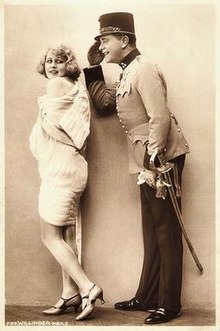코믹 타이밍
Comic timing코믹 타이밍은 연기자의 농담 전달에서 비롯된다: 그들은 청중과 상호작용하여 관객의 웃음을 유도하고, 그 후에 코믹한 [1][2][3]이야기를 유도한다.농담 전달의 페이스는 농담의 코믹 효과에 강한 영향을 미칠 수 있고 심지어 그 의미를 바꿀 수도 있다; 슬랩스틱과 [4]같은 더 많은 신체적인 코미디에서도 마찬가지일 수 있다.코믹 타이밍은 스매시 컷을 통해 농담의 효과를 극대화하기 위해 코미디 비디오 편집에도 매우 중요하다.
역사
희극 타이밍의 사용은 고대 그리스의 희극에서 처음 관찰될 수 있다.구체적으로, 아리스토파네스는 전개되는 [5]사건들로부터 웃음을 이끌어내기 위해 구름과 같은 그의 작품에서 잠시 멈추는 것을 암시했다.윌리엄 셰익스피어는 그 이전의 희곡 작가들과 함께 희곡의 많은 부분에서 희곡 타이밍을 활용했다.예를 들어, 안토니우스와 클레오파트라의 1막 2장에서 마크 안토니우스가 연설하는 동안 클레오파트라의 전략적인 개입은 그렇지 않으면 심각한 장면을 코믹한 [6]장면으로 바꾼다.조지 버나드 쇼는 특히 19세기 후반까지 코믹 타이밍의 사용을 계속했다.예를 들어 그의 1894년 희곡 '팔과 사나이'에서 쇼는 니콜라의 계산된 [7]침착성 분출로 2막의 마지막에 웃음을 유발한다.
무대에서 코믹 타이밍의 사용이 계속 번성하는 동안, 20세기 중반까지 코믹 타이밍은 코미디 영화, 텔레비전, 스탠드업 코미디에 없어서는 안 될 요소가 되었다.영화에서 찰리 채플린, 로렐과 하디, 그리고 버스터 키튼과 같은 코미디언들은 [8][9][10]각각 One A.M., The Lucky Dog, 그리고 The Playhouse와 같은 영화에서 정확한 타이밍을 통해 코미디 연기를 완성했다.TV에서, 루실 볼은 그녀의 쇼 아이 러브 루시에서 코믹한 타이밍을 사용했다.예를 들어 "Lucy Does a TV commercial" 에피소드에서 볼은 가짜 텔레비전 세트 내에서 광고를 연기하지만 TV의 네 번째 [11]벽이 코믹하게 시간적으로 깨지면서 환상을 깨뜨린다.스탠드업에서는 조지 칼린의 루틴 '텔레비전에서는 말할 수 없는 7가지 단어'가 처음 6단어와 7단어의 전달 타이밍 차이에서 웃음을 자아낸다.게다가, 로완 앳킨슨의 일상적인 "No One Called Jones"는 그의 학생 이름 목록에서 느린 코믹 타이밍을 이용하여 여러 개의 이중 엔트리를 드러냈다.
위의 역사는 특정한 작가와 연기자들을 강조하지만, 빅터 보르게에서 사카 바론 코헨 그리고 그 이후의 모든 희극 종사자들은 유머를 가장 효과적으로 전달하기 위해 코믹 타이밍을 이용했다.
쳐라.
비트는 코믹 타이밍을 목적으로 하는 일시정지이며, 종종 관객이 농담을 인식하고 반응하거나 예상되는 펀치 라인을 전달하기 전에 긴장감을 고조시키기 위해 사용됩니다.일시정지(이 문맥에서는 '극적 일시정지'[12]라고도 함)는 서브텍스트 또는 무의식적인 내용을 식별하기 위해 사용할 수 있습니다.즉, 화자가 실제로 생각하고 있는 것이 무엇인지입니다.포즈는 스위치를 방향으로 강조하기 위해서도 사용할 수 있습니다.연설자가 말할 때 청중들은 자연스럽게 빈칸을 채우고 예상된 생각의 끝을 완성한다.이 중단은 코미디언이 다른 결과를 전달하기 전에 일어나게 하고, 그래서 듣는 사람을 놀라게 하고 (희망적으로) 웃음을 자아낸다.
임신중 일시정지
임신 중 일시정지(고전적 정의에서 "많은 가능성"과 같이)는 코미디 요소를 강조하기 위해 사용되는 코믹 타이밍의 기술로, 한 구절의 끝에 코믹한 일시정지를 사용하여 서스펜스를 쌓는다.그것은 종종 우스꽝스러울 정도로 어색한 발언의 끝이나 겉으로 보기에 우스꽝스럽지 않은 문구 뒤의 침묵 속에서 재기하기 위해 사용된다.잭 베니가 특정한 몸짓 언어와 임신 중 멈춘 [13]구절을 소개하면서, 임신 중 멈춤은 스탠드업 코미디의 주요 요소가 되었다.
「 」를 참조해 주세요.
레퍼런스
- ^ Smith, Daniel R. (2018). "Part I: Analtical[:] The Professionalisation of Stand-Up Comedy[:] John Gordillo[:] IV. Expedience". Comedy and Critique: Stand-up comedy and the professional Ethos of laughter. Bristol Shorts Research. UK: Bristol University Press. p. 73. ISBN 978-1-5292-0015-7.
Gordillo's dramaturgy is built around form, not content: timing and rhythm are driven towards emotional escalation which seeks catharsis, but it is laughter which guides narrative. Narrative is, in this sense, a vanishing mediator (Jameson, 1973): the emotional intensity is drawn out in material but once this material has delivered laughter it becomes narratively void.
- ^ Davis, Andrew (2014) [2011]. Baggy Pants Comedy: Burlesque and the Oral Tradition. Palgrave Studies in Theatre and Performance History. Palgrave Macmillan. pp. 11, 70–71. ISBN 978-1-137-37872-9.
The written word is not effective at conveying such things as inflection, pace, rhythm—all the elements that go into what is loosely called comedy timing...Delivery is as important, if not more important, in the success of the joke... To a large extent this is because the word 'timing' has come to be applied to all aspects of joke-telling that are not directly related to the text of the joke itself—including such elements as pacing, rhythm, inflection, and other aspects of vocal delivery... At its most basic, timing is simply about 'waiting for the laughs,' pausing long enough for the laughs to start to die down before going on to the next joke or set-up line... Timing has a lot to do with including the audience as a part of this communication...Timing is often used to talk about delivery.
- ^ Dean, Greg (2000). Step by Step to Stand-up Comedy. Portsmouth, NH: Heinemann. p. 126. ISBN 0-325-00179-0.
The comedian doesn't have timing; the comedian spontaneously creates timing based on how he or she is being affected by the audience... it's an act of creativity that happens in the present
- ^ Capture Your Flag (2011-10-19), Matt Ruby on How to Improve Comic Timing, retrieved 2017-03-19
- ^ Timothy, Long (September 1976). "Understanding Comic Action in Aristophanes". The Classical World. The Johns Hopkins University Press. 70 (1): 1–8. doi:10.2307/4348563. JSTOR 4348563.
- ^ Hill, James (Spring 1986). ""What, Are They Children?" Shakespeare's Tragic Women and the Boy Actors". SEL: Studies in English Literature 1500–1900. Rice University. 26 (2): 235–258. doi:10.2307/450506. JSTOR 450506.
- ^ Dukore, Bernard (2002). "The Ablest Man in Bulgaria". Shaw: The Annual of Bernard Shaw Studies. 22: 67–82. doi:10.1353/shaw.2002.0006. S2CID 171024682.
- ^ Kamin, Dan (2011). The Comedy of Charlie Chaplin: Artistry in Motion. Scarecrow Press. p. 42. ISBN 978-0810877801.
- ^ Bliss, Michael (2017). Laurel and Hardy's Comic Catastrophes: Laughter and Darkness in the Features and Short Films. Rowman & Littlefield Publisher. p. 66. ISBN 9781538101537.
- ^ Knopf, Robert (1999). The Theater and Cinema of Buster Keaton. Princeton University Press. p. 63. ISBN 978-0691004426.
- ^ Landay, Lori (Summer 1999). "Millions "Love Lucy": Commodification and the Lucy Phenomenon". NWSA Journal. 11 (2): 25–47. doi:10.1353/nwsa.1999.0013. S2CID 144394351.
- ^ Pickering, Lucy. "Timing in the performance of jokes" (PDF). Tamuc.
- ^ "Well! Jack's Back: HBO tribute remembers the late comedian". Los Angeles Times. 1992-10-04. Retrieved 29 September 2018.


